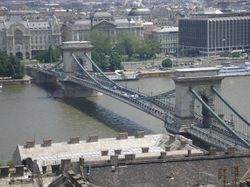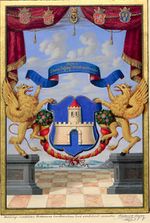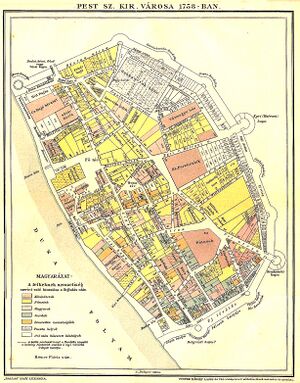پشت، المجر

Pest (النطق في المجرية: [ˈpɛʃt]) is the eastern, mostly flat part of Budapest, Hungary, comprising about two-thirds of the city's territory. It is separated from Buda and Óbuda, the western parts of Budapest, by the Danube River. Among its most notable sights are the Inner City, the Hungarian Parliament Building, Heroes' Square and Andrássy Avenue.
In colloquial Hungarian, "Pest" is often used for the whole capital of Budapest. The three parts of Budapest (Pest, Buda, Óbuda) united in 1873.
أصل الاسم
According to Ptolemy the settlement was called Pession in ancient times (Contra-Aquincum).[بحاجة لمصدر] Alternatively, the name Pest may have come from a Slavic word meaning "furnace", "oven" (Bulgarian пещ [ˈpɛʃt]; Serbian пећ/peć; Croatian peć), related to the word пещера (meaning "cave"), probably with reference to a local cave where fire burned.[1] The spelling Pesth was occasionally used in English, even as late as the early 20th century,[2] although it is now considered archaic.
التاريخ


Pest was originally founded as a Celtic settlement, then a fortified camp established by the Romans (Contra-Aquincum) across the river from their military border camp at Aquincum. Remains of the original Roman camp can still be seen at Március 15. tér.
During the Middle Ages, Pest was an independent city separate from Buda/Ofen, which became an important economic center during the 11th–13th centuries. The first written mention dates back to 1148.
Pest was destroyed in 1241 Mongol invasion of Hungary, but was rebuilt shortly thereafter.
Demographically, in the 15th century Pest was mostly Hungarian, while Buda across the Danube had a German-majority population.[4]

In 1838 Pest was flooded by the Danube; parts of the city were under as much as eight feet of water, and the flood destroyed or seriously damaged three-fourths of the city's buildings.[5] In 1849 the first suspension bridge, the Széchenyi Chain Bridge, was constructed across the Danube connecting Pest with Buda. Subsequently, in 1873, the two cities were unified with Óbuda to become Budapest.
أشخاص بارزون
- László Teleki (1811–1861), writer, statesman and magician
- Henrik Weber (1818–1866), painter
- تيودور هرتسل (1860–1904), founder of the political Zionist movement
- هاري هوديني (1874–1926), illusionist and escape acts performer
انظر أيضاً
- بوداپشت
- Inner City (Budapest)
- Pest County
- Újpest (New Pest)
- Kispest (Little Pest)
- Pestszentlőrinc (Saint Lawrence of Pest)
- بودا
- Óbuda (Old Buda)
المراجع
- ^ Adrian Room (2006). Placenames of the World. McFarland & Company. p. 70. ISBN 0-7864-2248-3.
- ^ "Pesth (part of modern-day Budapest), Hungary". www.1902encyclopedia.com.
- ^ أ ب Nyerges, András, ed. (1998). Pest-Buda, Budapest szimbólumai [Budapest arms & colours: throughout the centuries]. Budapest: Budapest Főváros Levéltára. p. 2.
- ^ "Budapest". A Pallas Nagy Lexikona (in الهنغارية). Retrieved 2009-11-03.
- ^ Nemes, Robert (2005). The Once and Future Budapest. DeKalb, Ill.: Northern Illinois University Press. p. 107. ISBN 0-87580-337-7.
للاستزادة
- Beksics, Gusztáv: Magyarosodás és magyarositás. Különös tekintettel városainkra. Budapest, 1883
وصلات خارجية
- CS1 الهنغارية-language sources (hu)
- Pages using gadget WikiMiniAtlas
- Short description with empty Wikidata description
- Articles with unsourced statements from April 2019
- Articles containing بلغارية-language text
- Pages with plain IPA
- Articles containing صربية-language text
- Articles with hatnote templates targeting a nonexistent page
- Coordinates not on Wikidata
- پشت، المجر
- Geography of Budapest

